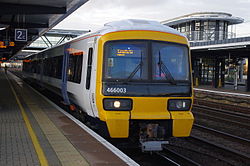History
At the launch of Network SouthEast in 1986, the 'Networker' series of trains was announced. [1] [2] It would be a new family of trains that would be introduced as a key part of NSE's wider plan to modernise their network. Specifically, it would replace various older types of trains, typically locomotive-hauled rakes of 'slam-door' carriages. [1]
Unlike previous contemporary rolling stock units in Britain, Networker trains would use aluminium bodies to save weight. Furthermore, electric units would feature modern AC traction motors and air conditioning. The design was to cover all requirements for future NSE multiple units, including new routes such as the Channel Tunnel Rail Link. [1] NSE intended for fleet procurement to be performed in a rolling fashion, ordering around 300 carriages per year.
The Networker was originally intended to become one of the largest families of trains, bigger even than the largely Mark 3-based Second Generation. [1] However, due to the recession in the early 1990s and the privatisation of British Rail from 1994, around 340 trains were built, substantially fewer than originally planned. [1]
This page is based on this
Wikipedia article Text is available under the
CC BY-SA 4.0 license; additional terms may apply.
Images, videos and audio are available under their respective licenses.











